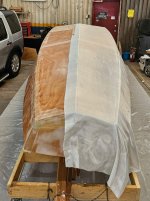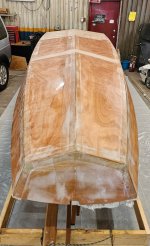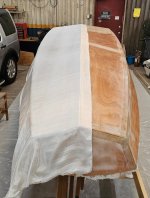Guilty. But trying. Or at least thinking about it.Bold talk for someone with the tolerances you are working to.
You are using an out of date browser. It may not display this or other websites correctly.
You should upgrade or use an alternative browser.
You should upgrade or use an alternative browser.
2025 Devlin Snow Goose Thread
- Thread starter HenryHawthorne
- Start date
If it looks 9 inches its certainly... well nvm.... i digress.Old school Tod. Unlike machining, with woodworking if it looks straight, it is straight. If it looks square, it is square.
Question re: the fill coat. I found initially epoxying the sheathing by pouring epoxy and spreading with a squeegee the most efficient, and generally managed to control dripping/flow even on the steep sides - but suspect that will be harder with the fill coat. Did you use any thickener for the fill coat? Or use a roller for application? I've found the roller to leave a lot of air bubbles that need to be tipped, but not sure that will work as well in the weave.
Henry
I put on two more flow coats after the original wetting and then sand to a frosty appearance. Then I address imperfections with epoxy thickened with microballons which are easy to sand.
I put on two more flow coats after the original wetting and then sand to a frosty appearance. Then I address imperfections with epoxy thickened with microballons which are easy to sand.
thanks!Henry
I put on two more flow coats after the original wetting and then sand to a frosty appearance. Then I address imperfections with epoxy thickened with microballons which are easy to sand.
I like a squeegee and brush. You are past this point, but the ideal way to do the fill coat is wet on wet, lay the second or third right on top when the first coat is just cured enough to hold the glass down tight to the wood. No sanding in betweenQuestion re: the fill coat. I found initially epoxying the sheathing by pouring epoxy and spreading with a squeegee the most efficient, and generally managed to control dripping/flow even on the steep sides - but suspect that will be harder with the fill coat. Did you use any thickener for the fill coat? Or use a roller for application? I've found the roller to leave a lot of air bubbles that need to be tipped, but not sure that will work as well in the weave.
Henry,
Ever consider a second layer of glass or dynel on the bottom for extra abrasion resistance followed by Tod's suggestion?
RM
Ever consider a second layer of glass or dynel on the bottom for extra abrasion resistance followed by Tod's suggestion?
RM
Thanks Tod!I like a squeegee and brush. You are past this point, but the ideal way to do the fill coat is wet on wet, lay the second or third right on top when the first coat is just cured enough to hold the glass down tight to the wood. No sanding in between
I debated xynole or dynel for a bit, but couldn't find either at a reasonable cost and ultimately decided against the additional weight.Henry,
Ever consider a second layer of glass or dynel on the bottom for extra abrasion resistance followed by Tod's suggestion?
RM
I may see if I have enough glass on hand to add a layer just on the bottom, that isnt a bad idea with our oyster beds.
Henry,I debated xynole or dynel for a bit, but couldn't find either at a reasonable cost and ultimately decided against the additional weight.
I may see if I have enough glass on hand to add a layer just on the bottom, that isnt a bad idea with our oyster beds.
I did two layers of 6 oz cloth on the bottom of both of my builds just for piece of mind. Dings and scrapes are inevitable but risk of water intrusion was my motivation for an extra layer. That said, I tend to over build; adding quality where it is not needed. For a fraction of the cost, take a look at S-Cloth. It has the abrasion resistance of kevlar and is easily sanded. RM
Last edited:
I told him the same thing. I think he wants it light for when he cartops it.Henry,
I did two layers of 6 oz cloth on the bottom of both of my builds just for piece of mind. Dings and scrapes are inevitable but risk of water intrusion was my motivation for an extra layer. That said, I tend to over build; adding quality where it is not needed. For a fraction of the cost, take a look at S-Cloth. It has the abrasion resistance of kevlar and is easily sanded. RM
After reading all the forum back to the beginning, I was just hoping that by ignoring at least 1 piece of your advice I could get a rise out of you.I told him the same thing. I think he wants it light for when he cartops it.
After reading all the forum back to the beginning, I was just hoping that by ignoring at least 1 piece of your advice I could get a rise out of you.But you seem to have chilled too much over the years.

I have become more accepting of the inherent level of stupidity that people seem to possess if that is what you mean.
Now we're getting closer to the Tod of legends.I have become more accepting of the inherent level of stupidity that people seem to possess if that is what you mean.
Now we're getting closer to the Tod of legends.
"Tod of legends" is laying it on a little thick, don't ya think?
As an old coach used to say, if you're going to walk on thin ice you might as well dance."Tod of legends" is laying it on a little thick, don't ya think?
You've been teaching a long time. Lots of data points to consider.I have become more accepting of the inherent level of stupidity that people seem to possess if that is what you mean.
I'm proud to be another data point!
But it seems I can be persuaded. I've ordered a bit of s-glass to bolster the bottom.
But it seems I can be persuaded. I've ordered a bit of s-glass to bolster the bottom.




